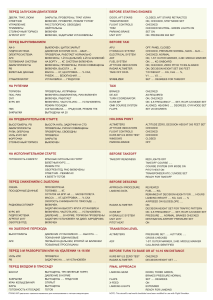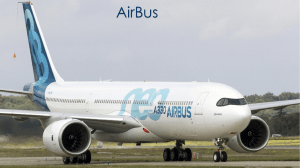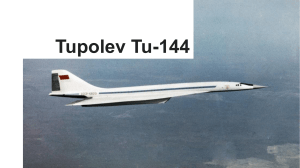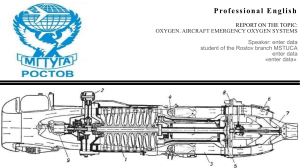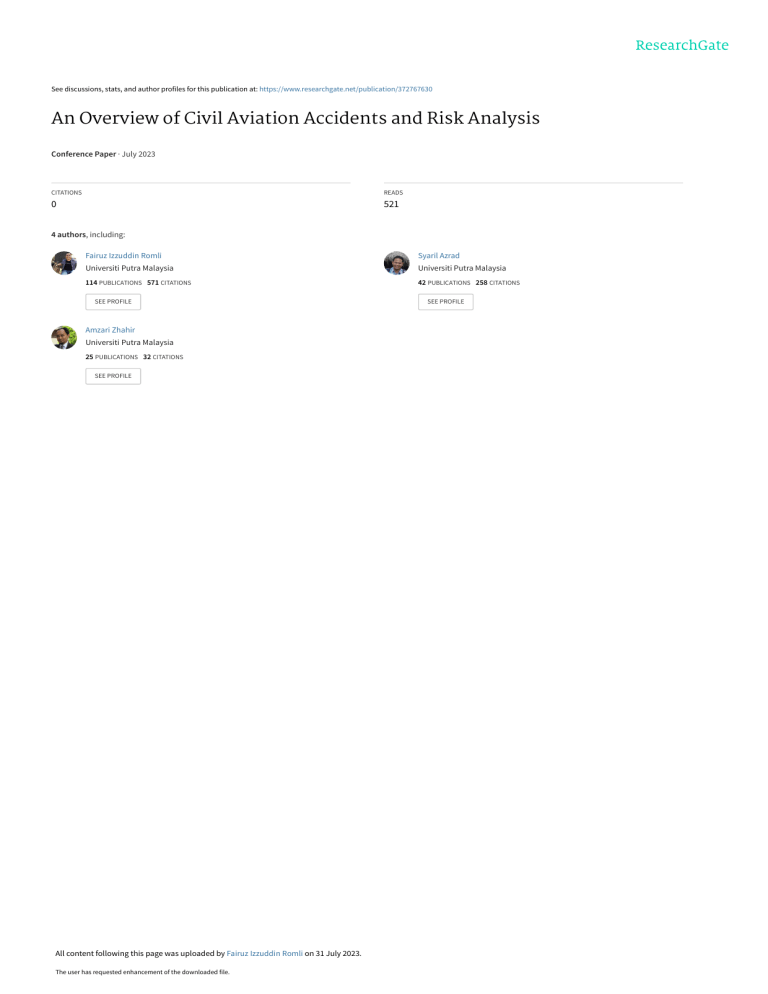
See discussions, stats, and author profiles for this publication at: https://www.researchgate.net/publication/372767630 An Overview of Civil Aviation Accidents and Risk Analysis Conference Paper · July 2023 CITATIONS READS 0 521 4 authors, including: Fairuz Izzuddin Romli Syaril Azrad Universiti Putra Malaysia Universiti Putra Malaysia 114 PUBLICATIONS 571 CITATIONS 42 PUBLICATIONS 258 CITATIONS SEE PROFILE Amzari Zhahir Universiti Putra Malaysia 25 PUBLICATIONS 32 CITATIONS SEE PROFILE All content following this page was uploaded by Fairuz Izzuddin Romli on 31 July 2023. The user has requested enhancement of the downloaded file. SEE PROFILE AEROS SYMPOSIUM 2023 AN OVERVIEW OF CIVIL AVIATION ACCIDENTS AND RISK ANALYSIS Li Xirui 1, 2, *, Fairuz Izzuddin Romli 1, Syaril Azrad Md Ali 1 and Md Amzari Md Zhahir 1 1. 2. Department of Aerospace Engineering, Faculty of Engineering, Universiti Putra Malaysia, 43400 Serdang, Selangor, Malaysia Zhengzhou University of Aeronautics, Henan, China * Correspondence: GS62953@student.upm.edu.my Abstract: Civil aviation safety has always been a prominent issue of general concern to the society. The causes of modern civil aviation accidents have become increasingly complex and diverse, which pose several new challenges to the study of aviation accidents and risks. This paper reviews the general civil aviation risk researches over the past 30 years, especially in the last 10 years, with the goal of providing research ideas for the evolution and innovation of the civil aviation risk analysis methods. Based on the CAST/ICAO Common Classification Team (CICTT) statistics, three main categories with the highest number of fatalities in civil aviation accidents are identified and selected as the main focus in this study: aircraft loss-of-control, controlled flight into terrain and runway excursion. The relevant research results for each of these types of accident are retrieved from literatures, outlining the process of applying the risk analysis to these accident types. Overall, in line with the progressing interest towards big-data-based risk analysis, both concerns about human factors and also confidence in future application and results of artificial intelligent (AI) technology in the civil aviation risk analysis on the large scale are highlighted. This paper concludes with discussion on the significance of building a risk management framework for deep learning models, which is crucial for the validity and credibility of the risk analysis. Keywords: Aviation risk; aircraft accidents; risk analysis; civil aviation; aviation safety. 1. Introduction Safety is always a paramount consideration in the civil aviation industry. With the worldwide rapid growth of airlines’ operations, the importance of aviation safety and risk is becoming more prominent. Today, a good safety record of an airline is critical towards its operational market survival, reputation, prestige and most importantly, passengers’ confidence towards its offered services [1]. While the current accident rate for civil aviation can be generally taken to be relatively much lower than most other types of transportation, the typically high severity of its consequences still call for better measures to avoid it from occurring. For instance, though there were only two aircraft accidents in Sudan for year 2003, the overall number of fatalities was 129 from these two events [2], which is evidently high for such a small number of accidents. Additionally, it is also good to note that despite the impacts of travel restrictions due to COVID-19 pandemic in 2020 that significantly reduced the total number of flights worldwide, number of air crash fatalities actually increased compared to previous year [3]. According to published statistics by International Civil Aviation Organization (ICAO), there were 298 fatalities from four fatal accidents in 2020. This situation can be taken to imply that the global aviation industry is facing serious and complex challenges when it comes to current aviation safety and risk management such that fatality risk remains high even with the reduced numbers of flights. It is therefore necessary to identify hidden problems and loopholes in the aviation system as quickly and accurately as possible in order to minimize the frequency of hazardous occurrences and ensure the reliability of civil aviation transportation system. Proceedings of Aerospace Society Malaysia, 2023, Vol. 1, Issue 1 53 AEROS SYMPOSIUM 2023 The study of civil aviation risks is generally focused on aircraft-related events. Among others, this covers all incidents that cause damage to the aircraft, injury or death to related personnel, and also affect flight safety during operation of civil aircraft or within the movement area of an airport. In other words, civil aviation risks typically relate to air traffic accidents that result in significant loss of life and property [4]. Figure 1 shows an example of aircraft accident, which happened due to a wind shear and killed 37 people onboard the aircraft. It is known that flight operations are often complex and encompass various elements that include humans, mechanical, technological and environmental, which subsequently makes the risks associated with flight operations are also equally complex and diverse [5]. To date, many studies have been conducted on the identification, analysis and management of different types of aviation risks. For example, various human risk factors that could cause runway incursions have been identified and categorized [6]. Moreover, several studies have also been pursued to assess and manage aviation risks in areas of maintenance [7], air traffic collisions [8] and weather [9]. While majority of these studies have been specifically focused on a certain type of aviation incidents only, there are also research works on aviation risks management that broadly covers the different accidents in general sense. For instances, many studies have been done in modeling aviation risks for evaluation and management using general aviation incidents data [10, 11]. In line with the latter approach, this research work refers to the aviation risk analysis as the process of identifying and analyzing the general potential issues that could negatively impact the safety of flight operations, which covers across several different types of aviation incidents and risk factors. Figure 1: Example of fatal aircraft accidents [12] In general, risk analysis and management process covers the identification, assessment and control of risks associated with a process or a system. As indicated by Shyur (2008), it is important to go beyond the common identification of risk factors to assess the safety performance and potential hazards of the airlines to ensure a safe aviation environment [13]. By this notion, risk assessment in aviation industry is expected to shift its emphasis towards “proactive safety”. The usual approach to study aviation risk is by analyzing the available accident data. In recent years, an increasing amount of data has become available to support the analysis of risk of various types of accidents or unsafe events in civil aviation. For example, National Transportation Safety Board (NTSB) reports contain the original textual account of any aviation accident or incident investigation. The availability of such data has led to the application of big data-based risk analysis techniques. The development of the technology, with its ability to assess and predict whether various types of events will lead to accidents, aircraft damage and/or fatalities, has greatly improved the understanding of aviation unsafe events and their consequences. As risk analysis Proceedings of Aerospace Society Malaysia, 2023, Vol. 1, Issue 1 54 AEROS SYMPOSIUM 2023 techniques continue to evolve, the ability of airline operators to be prepared to prevent accidents will also be greatly enhanced in the future. This paper reviews the general civil aviation risk researches over the past 30 years, especially in the last 10 years, with the goal of providing research ideas for the evolution and innovation of civil aviation risk analysis methods. Main categories of civil aviation accidents are identified and relevant researches for each of them are retrieved from the literature, along with discussions on the process of risk analysis for each type of accidents. 2. Methodology This review study is conducted based on a systematic review of published scientific literatures on civil aviation risk. Among others, it involves gathering, reading and categorizing literature, comparing and reviewing literature, predicting trends or suggesting questions for further research. The literature search is primarily based on two online databases: Scopus (www.scopus.com) and also Google Scholar (scholar.google.com). Among search phrases used singly or in Boolean queries during literature search include civil aviation, aviation accident, risk, loss of control, terrain, failure, runway, prediction and also evaluation. Initial screening process is done to compile all potential studies according to their titles and abstracts, which are then filtered after full review of the article text and removing duplications. It should be noted that the scope of this study is limited to airliner aircraft that are capable of carrying at least 12 passengers. By this notion, corporate jet aircraft and aircraft in military transport category are excluded, given the diversity of aviation. A total of 1,892 bibliographies have been retrieved during the literature search. After the screening, comparison and deduplication process, the total reduces to only 141 bibliographies. Each bibliography includes information such as abstract, keywords, authors, institutions, publications, volumes and also references. After reading through these papers and filtering them according to the sub-discipline, there are 21 important and novel papers that are highlighted in this paper. Moreover, to capture the global aviation accident data, IATA Safety Report 2020 published by International Air Transport Association (IATA) and Statistical Summary of Commercial Jet Airplane Accidents (Worldwide Operations 19592020) published by Boeing in September 2021 are referred to as well. 3. Results The CAST/ICAO Common Taxonomy Team (CICTT) is jointly chartered by International Civil Aviation Organization (ICAO) and Commercial Aviation Safety Team (CAST), which is composed of government representatives and aviation industry experts. Since 2001, Safety Indicator Steering Group (SISG), originally known as Occurrence Validation Study Group (OVSG), has convened annually to allocate CICTT occurrence categories to the incidents from the preceding year. This team is responsible to develop common taxonomies and definitions for aviation accident and incident reporting systems, which allow the assignment of multiple categories as necessary to appropriately describe the accident or incident categorization of aviation accidents or events. These standard categories are listed in Table 1. It can be observed from Table 1 that there is a wide variety of civil aviation risks as indicated by the various CICTT occurrence categories of civil aviation accidents. Some of these categories are fatal and some are non-fatal. Scientific scholars have often mostly focused more on the high-risk, high-casualty accident types. Moreover, Figure 2 presents the summary of top 10 accident categories based on the compilation of fatal accidents that had happened in the global commercial jet fleet over ten-year period (2011-2020) by IATA and Boeing. It can be observed that the top three categories with the highest number of fatal occurrence are LOC-I, CFIT and RE, which become the primary focus in this study. Proceedings of Aerospace Society Malaysia, 2023, Vol. 1, Issue 1 55 AEROS SYMPOSIUM 2023 Table 1: Principal categories of aviation accidents or events by CICTT [14] Category Abbreviation Brief Description Loss of control - In flight Unknown or Undetermined LOC-I CFIT System / Component Failure (NonPower plant) SCF-NP Runway Excursion (Take-off or Landing) Fuel Related Icing Those occurrences where there is not enough information at hand to classify the occurrence or where additional information is expected in due course to better classify the occurrence Collisions with those objects extending above the surface (e.g., towers, trees, power lines, cable car support) Cockpit crew is affected by visual illusions or degraded visual environment that result in the aircraft being flown under control into terrain or obstacle UNK Controlled Flight Into Terrain System / Component Failure (Power plant) Instrument Meteorological Conditions (IMC) or Visual Meteorological Conditions (VMC) As a result of a deliberate manoeuvre (e.g., stall/spin practice) SCF-PP Rotorcraft main rotor and tail rotor system, drive system and flight control failures or malfunctions Errors or failures in software and database systems Failures or malfunctions of any of the following: propellers, propeller system and engine gearbox, reversers and power plant controls All failures/malfunctions, including those related to maintenance issues RE Only applicable during either the take-off or landing phase The excursion may be intentional or unintentional. (e.g., the deliberate veer off to avoid a collision, brought about by a Runway Incursion) FUEL Exhaustion: No usable fuel remains on the aircraft Starvation: Usable fuel remains on the aircraft but not available to engines Accumulations that occur inflight or on the ground (i.e., de-icing-related) Carburettor and induction icing events are coded in the FUEL category ICE Ground Handling RAMP Mid-air/Near Mid-air Collision MAC Collisions that occur while servicing, boarding, loading, and deplaning the aircraft also during boarding and disembarking while helicopter is hovering Injuries to people from propeller/main rotor/tail rotor/fan blade strikes Aircraft separation, loss of situational awareness, navigation errors, altitude deviations, and traffic-alert and collision avoidance system Proceedings of Aerospace Society Malaysia, 2023, Vol. 1, Issue 1 56 AEROS SYMPOSIUM 2023 1000 10 900 9 800 8 700 7 600 6 500 5 400 4 694 0 300 3 36 200 322 100 Accidents Fatalities 1 10 1 21 154 157 127 229 2 0 71 0 Onboard fatalities External fatalities 1 0 12 3 7 9 0 0 Number of fatal accidents Figure 2: Occurrences of aviation accidents or events 3.1. Loss of Control - In Flight (LOC-I) There are various reasons for an aircraft to lose control while in the air, which are often the result of numerous different factors together. The comprehensive and very detailed study of LOC has been published in Ref. [15], which is the most cited reference in this field. In Ref. [15], analysis of 126 LOC accidents that occurred between 1979 and 2009, with total of 6087 fatalities, is presented. Using scatter plots created from the accident data, worst-case combinations of the causing and contributing elements have been identified. Furthermore, a detailed collection of 52 LOC sequences based on the temporal ordering of the causal and contributing components has also been created in that study. In continuation to their study, the same researchers have also led a research team at National Aeronautics and Space Administration (NASA) to develop the design for the future airborne integrated systems technology to prevent aircraft’s loss of control by enabling avoidance, detection, prevention and recovery from loss of control [16]. In the meantime, the specialists in both National Institute of Aerospace (NIA) and NASA have focused their study on the LOC accidents due to human factors, where they created the LOC accident framework (LOCAF) based on a thorough analysis of previous 20 years' worth of LOC accidents [17]. Object-oriented Bayesian belief network (OOBN) is used to define the LOCAF model and it includes causative elements in areas of human factors, component failures in aircraft systems and atmospheric environment. This study is successful in estimating the likelihood of LOC accidents. It should also be noted that the proposed LOCAF is supported and complemented by the Human Factors Analysis and Classification System (HFACS) and its maintenance extension (HFACS-ME) frameworks, which may capture human mistakes in flight crew and breakdown maintenance, respectively [17]. This LOCAF model is then further extended to support NASA Aviation Safety Program (AvSP) portfolio evaluation platform that is used by subject matter experts (SMEs) [18]. In conjunction to this, the LOCAF model Proceedings of Aerospace Society Malaysia, 2023, Vol. 1, Issue 1 57 AEROS SYMPOSIUM 2023 is evaluated to provide a predictive analysis platform to assess the impact of various NASA technologies on reducing the occurrence of future LOC incidents. Furthermore, NASA has been actively developing automated system to assist flight crews to reduce the probability of aircraft accidents. Based on the theory proposed by Wilborn and Foster (2004) [19], NASA has developed the flight loss-of-control prediction and prevention control system. The loss-ofcontrol prediction algorithm is aimed to spot events that could result in the aircraft losing control while the loss-of-control prevention system makes use of the data supplied by the prediction module to halt the development of a loss-of-control event. This system has been successfully simulated at the Beckman Institute, University of Illinois in Urbana-Champaign. According to the findings, this LOC prediction and prevention system does not impede the conduct of routine flying procedures and can indeed help the pilot ensure the safe operation of the aircraft in challenging climatic circumstances [20]. However, it is important to note that a LOC prevention system is essential and a more comprehensive solution is needed in the future, including for fault detection, isolation algorithms, flight-related laws and safety mechanisms to protect the system, among others. The current system does not address such causal and contributory factors at their source. In recent years, neural network algorithms have also been increasingly applied to aircraft loss-ofcontrol prediction. For instance, one study trained many feedforward neural networks offline using a Bayesian regularized backpropagation technique. In order to predict the worldwide flying envelope of the affected aircraft in real time, a trained network is deployed. The procedure is used in the instance of NASA general transport model's rudder and aileron failure [21]. Moreover, another study proposed a method to optimize the structure and training parameters of a neural network for belief state inference using Design of Experiments (DOE) statistical techniques. Through machine learning, the prediction results of a neural network can be used to infer changes in the state of an aircraft [22]. Similar to other machine learning, the current bottleneck for researchers is the inability to directly identify combinations with high balancing accuracy for the LOC detection, relying highly only on empirical tuning of training performance. 3.2. Controlled Flight into Terrain (CFIT) CFIT incidents typically happen when the aircraft is in its approach and landing stages. It has been established in numerous published studies that human factors are crucial accident causative factors for CFIT cases. For example, excessive dependence of human operators on the aircraft automation systems can be blamed for their complacency and lack of alertness [23]. Situational awareness can be defined as the capacity to recognize, comprehend and foresee the impact on the aircraft. In CFIT accidents, it is common for flight crews to have "lack situational awareness" and cause the accidents [24]. In particular, situational awareness essentially calls for pilots to be aware of the position, altitude, speed and projected course of the aircraft at all times. Contingency capabilities should be available in the event of inadequate task management, contradictory information, severe weather, lack of knowledge of the aircraft systems and poor planning. The essence of human factors in causing CFIT incidents is reflected in the findings from a survey of 50 CFIT accidents in 24 countries from 2007-2017, which revealed a total of 1,289 cases of individual human factors. The study found that approximately 44% of CFTT accidents occurred during the cruise flight phase and it could occur regardless of pilot experience. Distraction, complacency and fatigue are some of the contributing factors that can lead to CFIT accidents among flight crews during cruise [25]. In summary, the analysis indicates that human factors are the main cause of LOC and CFIT accidents. The HFACS framework is the most commonly used method for identifying human factors that affect flight safety. It is important to note, however, that although the contribution and causality of human Proceedings of Aerospace Society Malaysia, 2023, Vol. 1, Issue 1 58 AEROS SYMPOSIUM 2023 factors is similar across various flight accident categories, there are still some isolated differences that are worth noting. Similar to LOF accidents, air operators are actively developing airborne warning systems to prevent CFIT accidents. Researchers have also proposed converting passive warning systems to active warnings in two situations close to the ground, including the approach zone and the hazardous altitude zone, to improve warning effectiveness. To address issue of automatic departure moments at hazardous altitude, artificial neural networks have been used to help pilots in their decision-making. The resultant algorithm was applied at Sochi Adler Airport to verify the effectiveness of aircraft taxiing correction to prevent CFIT accidents on approach [26]. Early warning systems are informative and advisory in nature, hence corrective actions still depend entirely on the pilot's reaction time, analysis of the situation and the time available to execute the action. A warning that is too early is perceived as false alarm by the pilots while a warning that is too late deprives them of the time to properly react. Therefore, constant improvements have been made to the warning system to allow the aircraft to leave the dangerous altitude automatically in case of a real danger of collision with the terrain. 3.3. Runway Excursion (RE) Aviation accident investigators have identified that pilot’s unstable landing approach as the major contributor to the accident risk of REs in aircraft landing. Data analysis techniques on REs have been a hot research topic. For instance, researchers have simulated RE using logistic regression and Bayesian logistic regression. This method of data analysis improves the classic risk matrix's likelihood evaluation [27]. Furthermore, a model for predicting REs based on exponential weighting has also been developed. To anticipate REs, the influence coefficients of each index are calculated and superimposed using the risk levels and weights of the indices [28]. In addition, Multiple Correspondence Analysis (MCA) has also been applied to represent the five variable datasets of runway deviation as "cloud" points in multidimensional Euclidean space and established a model. The combination of variables obtained by the model can be used for runway risk assessment [29]. In order to determine the present degree of risk for various runway codes and movement types, a quantitative risk assessment methodology is devised for airport runway deviation accidents. This model includes a damage model that takes into account the observed statistical mechanical damage and a cumulative probability distribution that describes the end location of the aircraft following a turn. It also suggests control strategies to reduce the amount of risk [30]. The results of this experiment support the conclusion of pilot’s energy mismanagement, which is consistent with the factors found by FAA in aviation accidents and incidents that contribute to runway excursions [31]. The use of machine learning algorithms for REs has increasingly been the subject of many studies in recent years. For instance, researchers have created and tested prediction models for the National Airspace System's incorrect classification of unstable approach risk. Using the NASA-provided flight recorder data, six different machine learning algorithms have been assessed: logistic regression, decision tree, gradient boosting, random forest, and support vector machine. The decision tree model with three branches has the most effect of all of them and can predict the pilot's shaky landing issue by 98% with accuracy [32]. The results of the study likewise lead to the question that the core of prediction is data. While randomness of data is important, higher quality data is valuable and necessary for the accident prediction. Therefore, there is a need to consider the data quality during the preliminary data collection stage. 4. Summary of Findings and Conclusion According to the findings of various accident types, the human component is the most significant factor impacting civil aviation safety. Researchers have been innovating the technology to try to further Proceedings of Aerospace Society Malaysia, 2023, Vol. 1, Issue 1 59 AEROS SYMPOSIUM 2023 improve the reliability and automation of aviation systems. To prevent accidents, the warning system has been continuously enhanced. Under the control of flight warning management system, it is ensured that in the event of real danger such as collision, the aircraft can automatically leave the danger position. However, it should be realized that no technological innovation should allow for the decline of manual flight skills until there is a major breakthrough in the current aircraft’s autopilot system. The aviation industry is currently experiencing difficult times, with the worldwide restriction of air travel due to the COVID-19 epidemic leading to significant job losses for the aviation-related workers. Predictably, the resulting uncertainties are likely to lead to further safety issues. For example, following the recovery of the aviation industry, the "competence panic" among pilots and flight attendants could become a major issue and merits further discussion. Thanks to the development of artificial intelligence (AI) and big data technologies, deep learning techniques are able to be widely applied in the civil aviation risk analysis and prediction, providing more scientific and efficient solutions to civil aviation risk problems. For example, traditional neural networks are used to predict the icing conditions of civil aircraft at different intensities [33]. Moreover, multiple regression methods and neural networks have been used to make predictions about aircraft aging [34] whereas Bayesian belief networks have been applied to perform aviation risk assessment [35]. The risk prediction model is constructed by combining support vector machine (SVM) and deep neural network (DNN) algorithm [36]. The deep learning models have been increasingly used by researchers in the field of civil aviation security in recent years in an effort to address challenging issues that are hard to address using conventional analysis techniques. This phenomenon is also reflected from findings in literature as presented in previous sections. Nonetheless, although neural network-based deep learning models have achieved some results in solving traditional complex problems, validity and credibility of the data and prediction results remain a concern. In terms of data, issues with quality of the source data, amount of missing data and lack of standardized process with multi-factor studies are all prevalent at present. Typically, researchers use combined prediction accuracy metrics like mean square error (MSE) and mean absolute error (MAE) for the regression problem and the area under the receiver operating characteristic curve (AUROC) for classification problems, precision, recall and accuracy to evaluate quality of deep learning model systems [37]-[38]. While many low-risk applications could be satisfied with these metrics, applications that are extremely risk-sensitive such as aviation risk must place a premium on safety and quality. The adoption of deep learning models in crucial applications should be made more credible and AI can be ultimately made safe and dependable in the risk prediction applications by establishing a strict framework for risk management to prevent unexpected or harmful behavior of deep learning models in risk analysis. This is the anticipated next major research direction for researchers in the field of aviation risk analysis and management. References [1] [2] [3] [4] [5] Q. Cui and Y. Li, ‘The Change Trend and Influencing Factor of Civil Aviation Safety Efficiency: The Case of Chinese Airline Companies’, Safety Science, vol. 75, pp. 56-63, 2015. E. Ellatif and M. I. Shukri, “Analysis of Accidents in the Sudanese Civil Aviation During the Last 20 Years,” International Journal of Engineering Applied Sciences and Technology, vol. 6, pp. 249-254, 2022. D. Bartulovic and S. Steiner, ‘Conceptual Model of Predictive Safety Management Methodology in Aviation’, Aerospace, vol. 10, no. 3, 268, 2023. F. Netjasov and M. Janic, ‘A Review of Research on Risk and Safety Modelling in Civil Aviation’, Journal of Air Transport Management, vol. 14, no. 4, pp. 213-220, 2008. M. Hadjimichael, ‘A Fuzzy Expert System for Aviation Risk Assessment’, Expert Systems with Applications, vol. 36, no. 3, pp. 6512-6519, 2009. Proceedings of Aerospace Society Malaysia, 2023, Vol. 1, Issue 1 60 AEROS SYMPOSIUM 2023 [6] [7] [8] [9] [10] [11] [12] [13] [14] [15] [16] [17] [18] [19] [20] [21] [22] [23] [24] Y. Chang and K. Wong, ‘Human Risk Factors Associated with Runway Incursions’, Journal of Air Transport Management, vol. 24, pp. 25-30, 2012. N. Mendes, J. G. V. Vieira, and A. P. Mano, ‘Risk Management in Aviation Maintenance: A Systematic Literature Review’, Safety Science, vol. 153, 105810, 2022. P. Brooker, ‘Reducing Mid-Air Collision Risk in Controlled Airspace: Lessons from Hazardous Incidents’, Safety Science, vol. 43, no. 9, pp. 715-738, 2005. R. Ferraro, D. VanDyke, M. Zander, K. Anderson, and B. Kuehlen, ‘Risk Perception in Aviation Students: Weather Matters’, International Journal of Aviation, Aeronautics and Aerospace, vol. 2, no. 1, 1, 2015. M. Hadjimichael, ‘A Fuzzy Expert System for Aviation Risk Assessment’, Expert Systems with Applications, vol. 36, no. 3, pp. 6512-6519, 2009. C. Huang, A. Xie, and F. Mendonca, ‘Factorial Validity of the Flight Risk Assessment Tool in General Aviation Operations’, Journal of Aviation Technology and Engineering, vol. 9, no. 1, 41, 2020. B. C. Kok, H. Soh, ‘Trust in Robots: Challenges and Opportunities’, Current Robotics Reports, vol. 1, pp. 297-309, 2020. H. Shyur, ‘A Quantitative Model for Aviation Safety Risk Assessment’, Computers & Industrial Engineering, vol. 54, no. 1, pp. 34-44, 2008. J. G. Fuller, L. Hook, ‘Understanding General Aviation Accidents in Terms of Safety Systems’, Proceedings of AIAA/IEEE 39th Digital Avionics Systems Conference, San Antonio, USA, November 2020. C. Belcastro, J. Foster, ‘Aircraft Loss-of-Control Accident Analysis’, Proceedings of AIAA Guidance, Navigation and Control Conference, Toronto, Canada, August 2010. C. Belcastro, J. Foster, ‘Future Integrated Systems Concept for Preventing Aircraft Loss-ofControl Accidents’, Proceedings of AIAA Guidance, Navigation and Control Conference, Toronto, Canada, August 2010. E. Ancel, A. Shih, ‘The Analysis of the Contribution of Human Factors to the In-Flight Loss of Control Accidents’, Proceedings of AIAA Aviation Technology, Integration and Operations Conference and AIAA/ISSMO Multidisciplinary Analysis and Optimization Conference, Indianapolis, USA, September 2012. E. Ancel, A. T. Shih, S. Jones, M. S. Reveley, J. Luxhøj, J. K. Evans, ‘Predictive Safety Analytics: Inferring Aviation Accident Shaping Factors and Causation’, Journal of Risk Research, vol. 18, no. 4, pp. 428-451, 2015. J. Wilborn, J. Foster, ‘Defining Commercial Transport Loss-of-Control: A Quantitative Approach’, Proceedings of AIAA Atmospheric Flight Mechanics Conference and Exhibit, Rhode Island, USA, August 2004. J. Chongvisal, N. Tekles, E. Xargay, D. Talleur, A. Kirlik, N. Hovakimyan, ‘Loss-of-Control Prediction and Prevention for NASA's Transport Class Model’, Proceedings of AIAA Guidance, Navigation and Control Conference, Maryland, USA, January 2014. R. Norouzi, A. Kosari, M. H. Sabour, ‘Real Time Estimation of Impaired Aircraft Flight Envelope using Feedforward Neural Networks’, Aerospace Science and Technology, vol. 90, pp. 434-451, 2019. N. H. Campbell, J. A. Grauer, I. M. Gregory, ‘Use of Design of Experiments in Determining Neural Network Architectures for Loss of Control Detection’, Proceedings of IEEE Aerospace Conference, Big Sky, USA, March 2021. M. R. Endsley, ‘Toward a Theory of Situation Awareness in Dynamic Systems’, Human Factors, vol. 37, no. 1, pp. 32-64, 1995. R. O. Phillips, Investigation of Controlled Flight into Terrain: Descriptions of Flight Paths for Selected Controlled Flight into Terrain (CFIT) Aircraft Accidents: 1985-1997, Federal Aviation Administration, 1999. Proceedings of Aerospace Society Malaysia, 2023, Vol. 1, Issue 1 61 AEROS SYMPOSIUM 2023 [25] [26] [27] [28] [29] [30] [31] [32] [33] [34] [35] [36] [37] [38] D. Kelly, M. Efthymiou, ‘An Analysis of Human Factors in Fifty Controlled Flight into Terrain Aviation Accidents from 2007 to 2017’, Journal of Safety Research, vol. 69, pp. 155-165, 2019. A. P. Beliatskaia, V. V. Vorobev, B. P. Eliseev, ‘Research of the Methods of Collision Avoidance of Aircraft with the Ground in Controlled Flight during Landing’, Proceedings of Technical Scientific Conference on Aviation Dedicated to the Memory of NE Zhukovsky (TSCZh), Moscow, Russia, October 2021. D. C. S. Wagner, K. Barker, ‘Statistical Methods for Modeling the Risk of Runway Excursions’, Journal of Risk Research, vol. 17, no. 7, pp. 885-901, 2014. Y. Zhang, Y. Sun, Y. Chen, ‘Aircraft Runway Excursion Prediction Model based on Exponential Weight’, Proceedings of International Conference on Reliability, Maintainability and Safety (ICRMS), Hangzhou, China, October 2016. N. Distefano, S. Leonardi, ‘Aircraft Runway Excursion Features: A Multiple Correspondence Analysis’, Aircraft Engineering and Aerospace Technology, vol. 91, no. 1, pp. 197-203, 2019. L. Moretti, P. Di Mascio, S. Nichele, O. Cokorilo, ‘Runway Veer-Off Accidents: Quantitative Risk Assessment and Risk Reduction Measures’, Safety Science, vol. 104, pp. 157-163, 2018. Upset Prevention and Recovery Training: Advisory Circular 120-111, Federal Aviation Administration, 2017. E. V. Odisho, D. Truong, R. E. Joslin, ‘Applying Machine Learning to Enhance Runway Safety through Runway Excursion Risk Mitigation’, Journal of Aerospace Information Systems, vol. 19, no. 2, pp. 98-112, 2022. D. McCann, ‘NNICE – A Neural Network Aircraft Icing Algorithm’, Environmental Modelling & Software, vol. 20, no. 10, pp. 1335-1342, 2005. J. T. Luxhoj, T. P. Williams, H. Shyur, ‘Comparison of Regression and Neural Network Models for Prediction of Inspection Profiles for Aging Aircraft’, IIE Transactions, vol. 29, no. 2, pp. 91-101, 1997. P. Brooker, ‘Experts, Bayesian Belief Networks, Rare Events and Aviation Risk Estimates’, Safety Science, vol. 49, no. 8-9, pp. 1142-1155, 2011. X. Zhang, S. Mahadevan, ‘Ensemble Machine Learning Models for Aviation Incident Risk Prediction’, Decision Support Systems, vol. 116, pp. 48-63, 2019. H. A. Dolatsara, Y. Chen, C. Evans, A. Gupta, F. M. Megahed, ‘A Two-Stage Machine Learning Framework to Predict Heart Transplantation Survival Probabilities Over Time with Monotonic Probability Constraint’, Decision Support Systems, vol. 137, 113363, 2020. J. Chou, T. Nguyen, ‘Forward Forecast of Stock Price using Sliding-Window MetaheuristicOptimized Machine-Learning Regression’, IEEE Transactions on Industrial Informatics, vol. 14, no. 7, pp. 3132-3142, 2018. Proceedings of Aerospace Society Malaysia, 2023, Vol. 1, Issue 1 View publication stats 62
